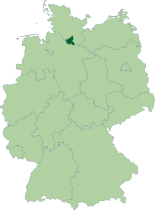Hamburg
Hamburg, or in full Free and Hanseatic City of Hamburg (German: Freie und Hansestadt Hamburg, Low German: Friee un Hansestadt Hamborg), is a city in the north of Germany on the banks of the River Elbe, 18 km away from the North Sea. It is also one of the States of Germany.
Free and Hanseatic City of Hamburg
| |
|---|---|
|
Descending, from top: View of the Binnenalster, St. Michael's Church, St. Nicholas' Church, Speicherstadt, and Hamburg Rathaus | |
 | |
| Coordinates: 53°33′55″N 10°00′05″E / 53.56528°N 10.00139°E | |
| Country | Germany |
| Government | |
| • First Mayor | Peter Tschentscher (SPD) |
| • Governing parties | SPD / The Greens |
| • Votes in Bundesrat | 3 (of 69) |
| Area | |
| • City | 755 km2 (292 sq mi) |
| Population (30 September 2016)[1] | |
| • City | 1,822,445 |
| • Density | 2,400/km2 (6,300/sq mi) |
| • Metro | 5,107,429 |
| Time zone | UTC+1 (CET) |
| • Summer (DST) | UTC+2 (CEST) |
| Postal code(s) | 20001–21149, 22001–22769 |
| Area code(s) | 040 |
| ISO 3166 code | DE-HH |
| Vehicle registration |
|
| GDP/ Nominal | € 111/$130 billion (2016) [2] |
| GDP per capita | € 62,000/$72,900[3] (2015) |
| NUTS Region | DE6 |
| Website | hamburg.de |
With a population of about 1.85 million (1850000), it is the biggest German city after Berlin and the sixth largest city of the European Union. The religion is about 37% Protestant, 10% Catholic, 8% Muslim, 38% agnostic, 2% Pagan.
Since it was an important member of the Hanseatic League, the city's official name still includes Hansestadt (Hanseatic city). Other German cities that do the same today are: Lübeck, Rostock, Wismar, Stralsund, Bremen, Greifswald and Demmin. The membership in this trade alliance has influenced the architecture of the city to a great extent. It has also left some marks in the region around the city. Strategic bombing in World War II devastated the city.
In 2017 a consulting company ranked it 17th for best place to live in the world.[4]
The area of Hamburg is 755.16 km2 (291.6 sq mi).[5] It has an oceanic climate (Cfb in the Köppen climate classification).
Economy
changeHamburg's harbour is, by shipments, the second largest harbour in Europe (after Rotterdam) and among the ten largest in the world. It is a very important gate to the countries along the Baltic Sea and Eastern Europe.
There are about 120,000 businesses in Hamburg.[6] The company Airbus has an assembly plant for large civil aircraft in Hamburg. 30,000 people are employed in Hamburg's aircraft industries. Only two other places in the world have so many: Seattle in the United States and Toulouse in France.
About half of Germany's nationwide newspapers and magazines are made in Hamburg. Germany's most-viewed television news Tagesschau is broadcast from Hamburg.
Hamburg's red-light district (in Sankt Pauli) is the largest in Europe.
Sister cities
changeRelated pages
changeReferences
change- ↑ "State population". Portal of the Land Statistics Office Hamburg. Archived from the original on 1 January 2016. Retrieved 15 November 2017.
- ↑ "Bruttoinlandsprodukt – in jeweiligen Preisen – in Deutschland 1991 bis 2016 nach Bundesländern (WZ 2008) – VGR dL". www.vgrdl.de. Archived from the original on 2015-06-26. Retrieved 2018-05-11.
- ↑ http://ec.europa.eu/eurostat/documents/2995521/7192292/1-26022016-AP-EN.pdf/602b34e8-abba-439e-b555-4c3cb1dbbe6e
- ↑ "Vienna tops Mercer's 19th Quality of Living ranking". Retrieved 2018-05-16.
- ↑ "Internetagentur Hamburg". www.internetagentur-seo-hamburg.de.
- ↑ "Archived copy" (PDF). Archived from the original (PDF) on 2008-10-12. Retrieved 2013-02-28.
{{cite web}}: CS1 maint: archived copy as title (link)
Other websites
change






